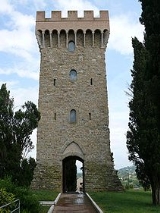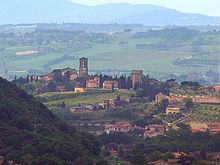
Torgiano
Encyclopedia
Torgiano is a comune
(municipality) in the Province of Perugia
in the Italian
region Umbria
, located about 10 km southeast of Perugia
.
Torgiano borders the following municipalities: Bastia Umbra
, Bettona
, Deruta
, Perugia
.
and Tiber
rivers. In Roman times it was called Turris Amnium.
Cabernet Sauvignon
and Chardonnay
wines, provided the named grapes comprise of at least 85% of the wine. Grapes for DOC production are limited to harvest
yields of 12 tonnes/ha with finished red wines needing a minimum alcohol level of 12% and finished whites needing at least 10.5% alcohol. The DOC red wines are blends of 50-70% Sangiovese
, 15-30% Canaiolo
, 10% Trebbiano
, and up to 10% of Ciliegiolo
and Montepulciano
. The whites are blends of 50-70% Trebbiano, 15-35% Grechetto
and up to 15% of Malvasia
and Verdello
.
Other sights include:
mark (Denomination of Origin) in 1968. In 1990 the Vino Torgiano was also certified as DOCG (Guaranteed Denomination of Origin). The town is a member of the Strada dei Vini del Cantico.
Also well known products from Torgiano are olive oil, terracotta, lace and embroidery.
One of the most inventive and progressive winemakers of Torgiano, Giorgio Lungarotti, together with his wife Maria Grazia, set up a foundation and conceived and created the Wine Museum, which opened in 1974 for the first time. The Olive Oil Museum in Torgiano is also part of the Lugarotti foundation.
There is a town soccer team in Torgiano named AC Torgiano, the soccer team is made up of the children who are residents of the town itself. The boys who play on the team are great friends and include teamwork in their everyday practice.

Comune
In Italy, the comune is the basic administrative division, and may be properly approximated in casual speech by the English word township or municipality.-Importance and function:...
(municipality) in the Province of Perugia
Province of Perugia
The Province of Perugia is the larger of the two provinces in the Umbria region of Italy, comprising two-thirds of both the area and population of the region. Its capital is the city of Perugia...
in the Italian
Italy
Italy , officially the Italian Republic languages]] under the European Charter for Regional or Minority Languages. In each of these, Italy's official name is as follows:;;;;;;;;), is a unitary parliamentary republic in South-Central Europe. To the north it borders France, Switzerland, Austria and...
region Umbria
Umbria
Umbria is a region of modern central Italy. It is one of the smallest Italian regions and the only peninsular region that is landlocked.Its capital is Perugia.Assisi and Norcia are historical towns associated with St. Francis of Assisi, and St...
, located about 10 km southeast of Perugia
Perugia
Perugia is the capital city of the region of Umbria in central Italy, near the River Tiber, and the capital of the province of Perugia. The city is located about north of Rome. It covers a high hilltop and part of the valleys around the area....
.
Torgiano borders the following municipalities: Bastia Umbra
Bastia Umbra
Bastia Umbra is a comune in the Province of Perugia in the Italian region Umbria, located about 15 km southeast of Perugia. As of 31 December 2004, it had a population of 20,523 and an area of 27.6 km²....
, Bettona
Bettona
Bettona is an ancient town and comune of Italy, in the province of Perugia in central Umbria at the northern edge of the Colli Martani range...
, Deruta
Deruta
Deruta is a hill town and comune in the Province of Perugia in the Umbria region of central Italy. Long known as a center of refined maiolica manufacture, Deruta remains known for its ceramics, which are exported worldwide.-History:...
, Perugia
Perugia
Perugia is the capital city of the region of Umbria in central Italy, near the River Tiber, and the capital of the province of Perugia. The city is located about north of Rome. It covers a high hilltop and part of the valleys around the area....
.
History
Probably founded by the Etruscans, Torgiano is situated on a hill overlooking the confluence of the ChiascioChiascio
The Chiascio is a river of Umbria, central Italy.It is part of the Tiber basin.- External links :* http://www.arpa.umbria.it/canale.asp?id=423...
and Tiber
Tiber
The Tiber is the third-longest river in Italy, rising in the Apennine Mountains in Emilia-Romagna and flowing through Umbria and Lazio to the Tyrrhenian Sea. It drains a basin estimated at...
rivers. In Roman times it was called Turris Amnium.
Torgiano DOC
The Italian wine DOC around Torgiano produced red and white blends, as well as varietalVarietal
"Varietal" describes wines made primarily from a single named grape variety, and which typically displays the name of that variety on the wine label. Examples of grape varieties commonly used in varietal wines are Cabernet Sauvignon, Chardonnay and Merlot...
Cabernet Sauvignon
Cabernet Sauvignon
Cabernet Sauvignon is one of the world's most widely recognized red wine grape varieties. It is grown in nearly every major wine producing country among a diverse spectrum of climates from Canada's Okanagan Valley to Lebanon's Beqaa Valley...
and Chardonnay
Chardonnay
Chardonnay is a green-skinned grape variety used to make white wine. It is originated from the Burgundy wine region of eastern France but is now grown wherever wine is produced, from England to New Zealand...
wines, provided the named grapes comprise of at least 85% of the wine. Grapes for DOC production are limited to harvest
Harvest (wine)
The harvesting of wine grapes is one of the most crucial steps in the process of winemaking. The time of harvest is determined primarily by the ripeness of the grape as measured by sugar, acid and tannin levels with winemakers basing their decision to pick based on the style of wine they wish to...
yields of 12 tonnes/ha with finished red wines needing a minimum alcohol level of 12% and finished whites needing at least 10.5% alcohol. The DOC red wines are blends of 50-70% Sangiovese
Sangiovese
Sangiovese is a red Italian wine grape variety whose name derives from the Latin sanguis Jovis, "the blood of Jove"...
, 15-30% Canaiolo
Canaiolo
Canaiolo is a red Italian wine grape grown through Central Italy but is most noted in Tuscany. Other regions with plantings of Canaiolo include Lazio, Marche and Sardegna. In Umbria a white berried mutation known as Canaiolo Bianco exist...
, 10% Trebbiano
Trebbiano
Trebbiano is the second most widely planted grape in the world. It gives good yields, but makes undistinguished wine at best. It can be fresh and fruity, but does not keep long. Its high acidity makes it important in Cognac production...
, and up to 10% of Ciliegiolo
Ciliegiolo
Ciliegiolo is a variety of red wine grape from Italy, named after the Italian for 'cherry'. It is a minor component of traditional blends such as Chianti, but interest has revived in recent years...
and Montepulciano
Montepulciano (grape)
Montepulciano is a red Italian wine grape variety that is most noted for being the primary grape behind the Denominazione di Origine Controllata e Garantita wine Montepulciano d'Abruzzo Colline Teramane and the Denominazione di origine controllata wines of Rosso Conero and Rosso Piceno.It should...
. The whites are blends of 50-70% Trebbiano, 15-35% Grechetto
Grechetto
Grechetto or Grechetto Bianco is an Italian wine grape of Greek origins. The grape is planted throughout central Italy, particularly in the Umbria region where it is used in the Denominazione di origine controllata wine Orvieto. It is primarily a blending grape, though some varietal wine is also...
and up to 15% of Malvasia
Malvasia
Malvasia is a group of wine grape varieties grown historically in the Mediterranean region, Balearic islands, Canary Islands and the island of Madeira, but now grown in many of the winemaking regions of the world...
and Verdello
Verdello
Verdello is a comune in the province of Bergamo, Lombardy, Italy. It has a population of 6,494....
.
Torgiano Rosso Riserva DOCG
Within the DOC 160 ha (499 acres) in the nearby hills received a special designation to produce a DOCG red wine. Grapes designated for this wine are further restricted to 10 tonnes/ha, a minimum alcohol level of 12.5% and must be aged at least 3 years prior to release. The blending components are mostly similar to the DOC wine in regards to the percentages of Sangiovese and Canaiolo but differ in that now collectively Trebbiano, Ciliegiolo and Montepulciano can not account for more than 10% of the blend.Main sights
The ancient part of town is still partly surrounded by medieval walls. The Torre di Guardia, a defensive tower dating back to the 13th century, is situated outside the walls.Other sights include:
- San Bartolomeo church.
- Oratory of St. Anthony (16th century) with frescos of the Domenico AlfaniDomenico AlfaniDomenico Alfani was an Italian painter of the Renaissance period, active chiefly in his native Perugia.He was a contemporary of Raphael, with whom he studied in the school of Pietro Perugino...
school. - Museo del vinoMuseo del vino (Torgiano)The Wine Museum of Torgiano is a private museum, specialized and completely dedicated to the culture of wine.Located in an area of wine production, the museum was founded by the wine producers Giorgio Lungarotti and his wife Maria Grazia Marchetti in 1974 and is run, together with the Olive and...
(Wine museum) - Museo dell'olivo e dell'olioMuseo dell'olivo e dell'olioThe Museo dell'olivo e dell'olio is a private museum located in Torgiano specialized in olive oil and olive culture and knowledge...
(Olive and oil museum) - La Strada del Vino e dell’Arte – the Wine and Art Itinerary to Brufa.
- Brufa with its sculptures.
Culture
Torgiano was the first winemaking area in Umbria to obtain the DOCDenominazione di Origine Controllata
Denominazione di origine controllata is a quality assurance label for food products, especially wines and various formaggi . It is modelled after the French AOC...
mark (Denomination of Origin) in 1968. In 1990 the Vino Torgiano was also certified as DOCG (Guaranteed Denomination of Origin). The town is a member of the Strada dei Vini del Cantico.
Also well known products from Torgiano are olive oil, terracotta, lace and embroidery.
One of the most inventive and progressive winemakers of Torgiano, Giorgio Lungarotti, together with his wife Maria Grazia, set up a foundation and conceived and created the Wine Museum, which opened in 1974 for the first time. The Olive Oil Museum in Torgiano is also part of the Lugarotti foundation.
There is a town soccer team in Torgiano named AC Torgiano, the soccer team is made up of the children who are residents of the town itself. The boys who play on the team are great friends and include teamwork in their everyday practice.
Events
- Gustando il borgo - spring festival (Easter)
- Infiorata del Corpus Domini
- Calici di Stelle - Food and wine review Torgiano, tastings of wine and typical products. - (August, 10 - national winetasting congress (November - December)
- Mostra d'arte “Vaselle d'autore per il vino novello” – festival of the new wine (November)
- Festa dell’Olio Nuovo – festival of the new olive oil (December)

External links
- www.comune.torgiano.pg.it
- Strada dei Vini del Cantico
- Vinarelli, art initiative
- Olive Oil Museum
- Wine Museum
- Banco d’Assaggio dei Vini d’Italia, national wine congress
- Pro Loco Brufa in Italian

